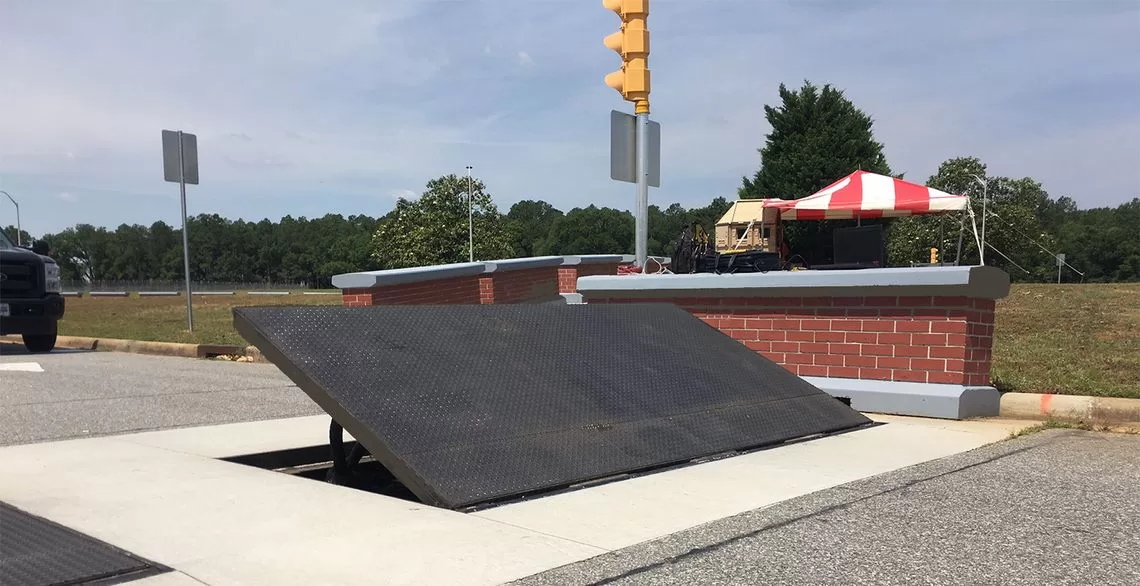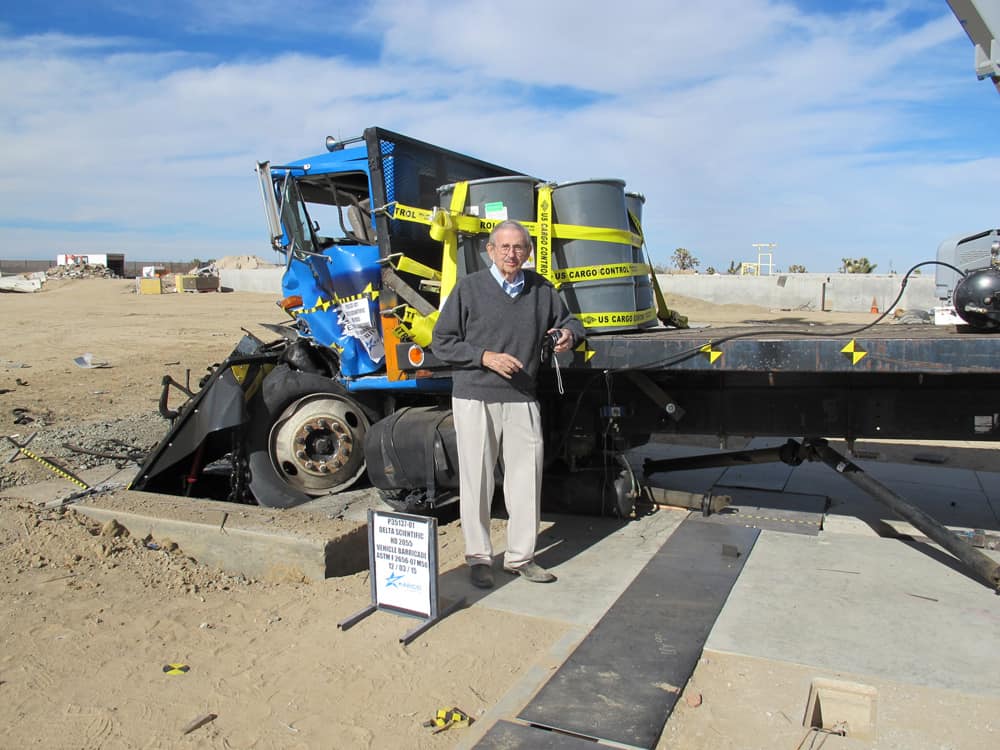Wedge Barriers Things To Know Before You Get This
What Does Wedge Barriers Do?
Table of ContentsWedge Barriers - An OverviewThe Only Guide to Wedge Barriers

14 and the surface area 12 to which the barrier 10 is secured might be made from concrete - Wedge Barriers. 2, the obstacle 10 is mounted to or consists of an anchor or subframe (e. g., anchor 30 displayed in FIG. 2 )safeguarded beneath the surface 12. The bather 10 might be bolted to the support or protected to the support by various other mechanical fasteners. In the illustrated personification, the obstacle 10 consists of a wedge plate 16, that includes a portion that is significantly parallel with the surface 12 when the obstacle 10 remains in the pulled back setting. In other words, cars or people may pass over the barrier 10 when the obstacle 10 remains in the withdrawed setting and experience minor altitude loved one to the surface area 12 while on the obstacle 10. As gone over thoroughly below, when the barrier 10 is in the released placement, the wedge plate 16 is held and sustained in an elevated placement by a training system of the barrier 10. Additionally, the components 18 might be bolted or otherwise mechanically combined to each other. In this manner, repair or replacement of several components 18 might be streamlined and structured. That is, repair work or substitute of single elements
18 might be done quicker, conveniently, and cost efficiently. FIG. In particular embodiments, the support 30 may be a steel structure including plates, beams(e. g., I-beams ), and/or various other frameworks that are secured within the structure 14, which may be concrete. At the surface area 12, a top side 28 of the anchor 30 might be at the very least partly subjected
, consequently enabling the accessory of the obstacle 10 to the anchor 30. g., threaded openings)in several beam of lights or plates of the anchor 30 might be exposed to the surface area 12. In this manner, bolts 32 or various other mechanical fasteners may be made use of to secure the obstacle 10 to the support 30. As the barrier 10 is placed to the surface 12 of the structure 14, collection of particles and other product underneath the barrier may be lowered, and elements of the bather 10 may not be revealed to listed below grade atmospheres. As indicated by reference numeral 52, the lifting mechanism 50 consists of elements got rid of below the wedge plate 16. The components 52 under the wedge plate 16 may include an electromechanical actuator, a web cam, one or more webcam surface areas, and so forth. Additionally, the lifting device 50 includes a springtime setting up 54
The springtime pole 58 is combined to a web cam(e. g., web cam 80 received FIG. 4) of the lifting mechanism 50. The springs 60 disposed about the spring rod 58 are held in compression by springtime sustains 62, consisting of a taken care of springtime assistance 64. That is, the additional info set springtime assistance 64 is dealt with about the foundation 14 and the remainder of the bather 10.
Things about Wedge Barriers
The staying pressure applied to
the cam camera deploy the wedge plate 16 may might provided offered an electromechanical actuator 84 or other various other. The spring assembly 54 and the actuator 84(e. Wedge Barriers. g., electromechanical actuator)might run with each other to equate the web cam and lift the wedge plate 16.
As stated above, the springtime assembly 54 applies a consistent force on the camera, while the electromechanical actuator may be managed to put in a variable pressure on the cam, thus making it possible for the lifting and reducing( i. e., releasing and retracting )of the wedge plate 16. In specific personifications, the constant force used by the spring setting up 54 may be flexible. g., electromechanical actuator) is disabled. As will certainly be valued, the springtime assembly 54 may be covered and protected from particles or various other components by a cover plate(e. g., cover plate 68 displayed in FIG. 4) that might be significantly flush with the elevated surface 38 of the structure 14. As discussed over, in the deployed placement, the wedge plate 16 offers to obstruct access or travel beyond the barrier 10. For instance, the barrier 10(e. g., the wedge plate 16 )may block pedestrians or automobiles from accessing a property or pathway. As reviewed over, the obstacle 10 is affixed to the support 30 protected within the structure 14,

front braces 71. Consequently, the link settings up 72 may pivot and turn to make it possible for the collapse and extension of the affiliation assemblies 72 throughout retraction and deployment of the bather 10. The affiliation assemblies 72 reason activity of the wedge plate 16 to be restricted. If a vehicle is traveling towards the deployed wedge plate 16(e. For example, in one circumstance, the security legs 86 may be prolonged duringmaintenance of the barrier 10. When the security legs 86 are released, the security legs 86 sustain the weight of the wedge plate 16 versus the surface 12. Consequently, the training mechanism 50 may be shut off, serviced, gotten rid of, changed, etc. FIG. 5 is partial viewpoint view of an embodiment of the surface-mounted wedge-style barrier 10, illustrating the webcam 80 and the webcam surfaces 82 of the lifting mechanism 50. Specifically, two webcam surfaces 82, which are referred to as lower webcam surface areas 83, are placed listed below the web cam 80. The reduced cam surfaces 83 might be dealt with to Continue the surface area 12 (e. For instance, the reduced web cam surfaces 83 and the placing plate 85 might create a single item that is safeguarded to the support 30 by screws or other mechanical fasteners. Furthermore, 2 webcam surfaces 82, which are click over here described as top webcam surface areas 87, are placed over the camera 80 and combined to (e. In various other personifications, interfering layers or plates may be positioned in between the surface 12 and the lower cam surface areas 83 and/or the wedge plate 16 and the top cam surfaces 87 As pointed out above, the web cam
80 equates along the cam surface areas 82 when the wedge plate 16 is raised from the pulled back position to the released position. In addition, as discussed above, the springtime setting up 54 (see FIG. 3 )might supply a force acting on the webcam 80 in the instructions 102 through springtime rod 58, which might minimize the pressure the electromechanical actuator 84 is required to use to the cam 80 in order to activate and lift the wedge plate 16. 1 )to the deployed placement(see FIG. 4). As shown, the webcam 80 consists of track wheels 104(e. g., rollers), which get in touch with and convert along the web cam surfaces 82 throughout operation.